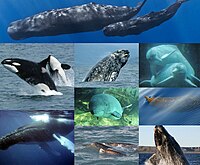
Photo from wikipedia
Cetacean strandings are a constant phenomenon that occurs on coastlines; mortality is related to several factors but commercial fishing is considered one of the main pressures, in the Mediterranean, that… Click to show full abstract
Cetacean strandings are a constant phenomenon that occurs on coastlines; mortality is related to several factors but commercial fishing is considered one of the main pressures, in the Mediterranean, that can impact small cetacean species such as common bottlenose dolphin (Tursiops truncatus) and striped dolphin (Stenella coeruleoalba). Since all eight species of cetaceans residing in the Mediterranean Sea are listed in the Habitats Directive, there is a legislative and management need to survey and report their conservation status every 6 years. The aim of this study was to assess the relationship, in Sicily, between strandings of two species and the fishery capacity, using records from 1995 to 2012. Positions and densities of all the strandings were compared with values of engine power from all the fishing vessels registered in 48 Sicilian ports. In addition, the relationship between strandings and the wild population at sea was investigated. Results showed that trends of fishing capacity and strandings both decreased, with a strong positive association. Trends were also confirmed when data were grouped into “6-year periods” or into different geographical sub-areas. Strandings were clustered near ports with higher fishing capacities; S. coeruleoalba records were distributed more homogenously along the coastline compared to T. truncatus, whose strandings were mostly distributed on the southern coastline, where the fishing capacity of bottom otter trawls was greater. The ratio between the two cetacean species was similar both for strandings and at-sea populations. Results show that fishing capacity is a pertinent indicator of pressure/threat to small cetacean species, and stranding records could complement at-sea data to assess population status within the framework of EU Directives.
Journal Title: European Journal of Wildlife Research
Year Published: 2017
Link to full text (if available)
Share on Social Media: Sign Up to like & get
recommendations!